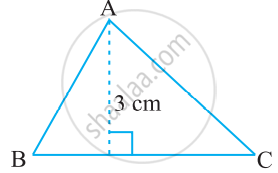Advertisements
Advertisements
Question
If the coordinates of the mid-points of the sides of a triangle are (1, 1), (2, —3) and (3, 4), find the vertices of the triangle.
Solution
The coordinates of the midpoint `(x_m,y_m)` between two points `(x_1,y_1)` and `(x_2, y_2)` is given by,
`(x_m,y_m) = (((x_1 + x_2)/2)"," ((y_1 + y_2)/2))`
Let the three vertices of the triangle be `A(x_A,y_A),B(x_B, y_B)` and `C(x_C, y_C)`
The three midpoints are given. Let these points be `M_(AB) (1,1), M_(BC) (2, -3)`and `M_(CA) (3,4)`
Let us now equate these points using the earlier mentioned formula,
`(1,1) = (((x_A + x_B)/2)","((y_A + y_B)/2))`
Equating the individual components we get,
`x_A + x_B = 2`
`y_A + y_B = 2`
Using the midpoint of another side we have,
`(2,-3) = (((x_B + x_C)/2)","((y_B + y_C)/2))`
Equating the individual components we get,
`x_A + x_C= 6`
`y_A + y_C= 8`
Adding up all the three equations which have variable ‘x’ alone we have,
`x_A + x_B + x_B + x_C + x_A + x_C = 2 + 4 + 6`
`2(x_A + x_B + x_C) = 12`
`x_A + x_B +x_C = 6`
Substituting `x_B + x_C = 4` in the above equation we have,
`x_A + x_B + x_C = 6`
`x_A + 4 = 6`
`x_A = 2`
Therefore,
`x_A + x_C= 6`
`x_C = 6 - 2`
`x_C = 4`
And
`x_A + x_B 2`
x_b = 2 - 2
`x_B = 0`
Adding up all the three equations which have variable ‘y’ alone we have,
`y_A + y_B + y_B + y_C + y_A + y_C= 2 - 6 + 8`
`2(y_A + y_B + y_C) = 4`
`y_A + y_B + y_C = 2`
Substituting `y_B + y_C = -6` in the above equation we have,
`y_A + y_B + y_C = 2`
`y_A - 6 = 2`
`y_A = 8`
Therefore,
`y_A + y_C = 8`
`y_C = 8 - 8`
`y_C = 0`
And
`y_A + y_B = 2`
`y_B = 2 - 8`
`y_B = -6`
Therefore the co-ordinates of the three vertices of the triangle are A(2,8), B(0, -6), C(4, 0)
APPEARS IN
RELATED QUESTIONS
Find values of k if area of triangle is 4 square units and vertices are (k, 0), (4, 0), (0, 2)
Find a relation between x and y, if the points A(x, y), B(-5, 7) and C(-4, 5) are collinear.
Find the value of p for which the points (−5, 1), (1, p) and (4, −2) are collinear.

In Figure 1, PS = 3 cm, QS = 4 cm, ∠PRQ = θ, ∠PSQ = 90°, PQ ⊥ RQ and RQ = 9 cm. Evaluate tan θ.
Using integration, find the area of triangle ABC, whose vertices are A(2, 5), B(4, 7) and C(6, 2).
Find BC, if the area of the triangle ABC is 36 cm2 and the height AD is 3 cm.

Find the value of m if the points (5, 1), (–2, –3) and (8, 2m) are collinear.
Find the area of the triangle whose vertices are (–8, 4), (–6, 6) and (–3, 9).
Find the cost of laying grass in a triangular field of sides 50 m, 65 m and 65 m at the rate of Rs 7 per m2.
If area of a triangular piece of cardboard is 90 cm2, then the length of altitude corresponding to 20 cm long base is ______ cm.
